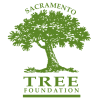Community scientists in training spot Dutch elm disease
by Jason Sullivan-Halpern
May 7, 2017

It was a cool yet sunny morning as our team of volunteer community scientists for SacTree’s Save The Elms Program met at Curtis Park for our first Saturday morning walkabout with certified arborist Dan Pskowski this year. Everyone was wearing their stylish T-shirts and ready to learn more about American and English elm trees, identifying the symptoms of Dutch elm disease (DED), and using our app to report elm trees with symptoms of the disease. Dan has been an arborist for 30+ years and spent many of them working with City of Sacramento Urban Forestry, SacTree’s partner on this important project, to quell the spread of this unwelcome pest across our city, so he knows more about DED than almost anyone. Given that two of our beloved mature public elms near the Sierra 2 Center were just confirmed to have DED and removed by the City, our location and timing couldn’t have been more perfect.

Dan started by telling us about his experience with DED, how it spreads, what its symptoms are, and what the city is doing to stop its spread. He walked us through his process for monitoring elms for DED: thoroughly examining the tree from top to bottom walking around its drip line, looking for yellow, wilted leaves that seem to be localized to certain branches or spreading up the base of the tree, and eliminating any other issues that may cause similar symptoms – such as squirrel damage. Squirrels love the elms’ inner bark, and they chew around the branch until all the twig’s water-conducting vessels (which are close to the surface) are eaten, causing the leaves to turn yellow and die. You can typically follow the branch — with binoculars, if it’s too high — until you find evidence of the squirrels’ destruction. When leaves die due to DED, you won’t see corresponding bark damage.

As we walked north through the park, we monitored all the American and English elms along the way. The binoculars we provided for our community scientists this year helped a lot! Having more eyes on each of our elms helped too. Luckily, we didn’t see any symptoms of DED on any of those trees. We did, however, see lots of terrific examples of elms and elm relatives that are DED-resistant, like the Zelkovas available from our free shade tree program.

As soon as we rounded the corner onto 5th Avenue, we saw a suspicious looking elm. Dan and our team immediately walked over to investigate. While inspecting the tree, we found wilted leaves on one of the lower branches but not the others, and with no evident cause – a prime example of how DED looks when it first begins to spread up the tree. Our community scientists took photographs of the tree’s symptoms using their cell phones and uploaded them to the app right away. The elm’s city tree ID was referenced in order to alert the City of Sacramento Urban Forestry that this particular elm might have DED and it should be tested as soon as possible. If the city confirms the tree has DED, they will remove the tree entirely to stop the disease from spreading. Early detection of the disease, if confirmed, means there’s a better chance that something can be done to save the three elms directly beside this one too.
We can’t thank Dan enough for sharing his time and expertise with all of us. Our community scientists felt more confident than ever in their mission to save Sacramento’s elms from DED and are looking forward to adopting and monitoring their own public elms soon. There are likely more elms with DED that need to be discovered! The faster we can find them, the longer we can enjoy our elms’ environmental, social, economic, and psychological benefits.

